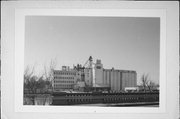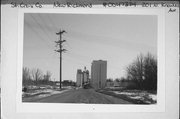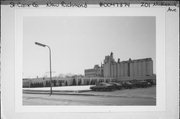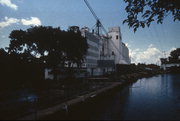Property Record
201 N KNOWLES AVE
Architecture and History Inventory
| Historic Name: | New Richmond Roller Mills Co. |
|---|---|
| Other Name: | New Richmond Roller Mills Company |
| Contributing: | |
| Reference Number: | 47374 |
| Location (Address): | 201 N KNOWLES AVE |
|---|---|
| County: | St. Croix |
| City: | New Richmond |
| Township/Village: | |
| Unincorporated Community: | |
| Town: | |
| Range: | |
| Direction: | |
| Section: | |
| Quarter Section: | |
| Quarter/Quarter Section: |
| Year Built: | 1916 |
|---|---|
| Additions: | 1946 |
| Survey Date: | 1983 |
| Historic Use: | grain elevator/feed mill |
| Architectural Style: | Astylistic Utilitarian Building |
| Structural System: | |
| Wall Material: | Concrete |
| Architect: | R.w. Folwell-1916; Magney, Tusler and Setter-1946 |
| Other Buildings On Site: | |
| Demolished?: | Yes |
| Demolished Date: | 2003 |
| National/State Register Listing Name: | New Richmond Roller Mills Co. |
|---|---|
| National Register Listing Date: | 5/31/1988 |
| State Register Listing Date: | 1/1/1989 |
| National Register Multiple Property Name: | Multiple Resources of New Richmond |
| Additional Information: | The Doboy and Domain complex consists of the mills, storage, elevators and offices. Reinforced concrete is the exterior fabric. The west side of the mills and elevators has numerous steel supports and connectors. The mill is five stories. A post WWII addition connects it to the elevator section. Farther north of this is another elevator or storage building. Corporate offices were built in 1946 and are just east of the mill. They are a one story concrete building with flat roof and various windows. The complex is located on the north edge of the Willow River where a dam was built (still there). The 1916 era mills and elevator have retained much of their original intetrity. The addition between them does not detract and is recognizable as an addition. They do not appear to have architectural significance. The greater importance of the mill is in its significance in the develdopment of the community. See SC 31-9 for a view of the offices and mill and SC 31-25 for the separate elevator. A Doboy packing plant is at 155 West Third Street (SC 34-33) and a new plant is further south (869 South Knowles - no photo). Background: In the 1850s a dam was built on the Willow River to hold logs for the sawmill. The site proved ideal for a grist mill. Farmers had been grinding their own wheat into flour. Now they could have it ground into flour, bran, middlings, etc. As payment the mills kept some flour and sold it to city residents. The first mill on this site was built by Pierce in 1867. Turner and Rollins bought the mill only to see it destroyed by a flood in 1876. William Johnston (see residences SC20-9, 467 West First Street and SC29-34, 447 West First Street) built a mill in 1882. In 1883 Orville W. Mosher (see residence SC20-4, 111 South Dakota Avenue), William F. McNally (see residence SC20-19, 257 West Second Street). He also owned Willow River Lumber Company. The panic of 1893 slowed down business and financial aid was obtained from the Bank of New Richmond (see SC24-32, 201 South Knowles Avenue). On 1895 Glover and the McNally's are listed as the mills' owners. The 1899 tornado damaged the mills and in August of that year they were reorganizd with Mosher as president, John McNally as manager and superintendent, William and Miles McNally as company attorneys. The mills were formally incorporated as the New Richmond Roller Mills at this time. Mosher had organized Northern Grain in c.1890. This now provided a line of elevators for the roller mdills to sh ip and store grain as needed. The elevators oculd be leased. In 1909 there were two other elevators in New Richmond. The Roller Mills, Williams elevator (storage only) and the New Richmond elevator. The roller mills bought out New Richmond elevator. They were both lost in a 1916 fire. The present mills and elevators date from 1916. They were rebuilt on the same site. Major changes at this time included using sacks rather than barrels to pack the flour and, more importantly, a change from stone to steel mills that were more efficient. The first stage in themills modernization had begun. Smaller mills began to use the roller mills facilities instead of grinding their own. Huntingdon Power Company was built by the mills to furnish power (this was sold later). The second stage in the mills modernization occured when E.J. Chasman became president c. 1936 and diversification began. A heat sealing machine was perfected and used during WWII. Other plastic productes were made. A company printing press was run for a time. The name was changed to The New Richmond Company, Doboy Mills and Doby Industries. Today the mills are kn own as Domain, Inc. andDoboy Packaging, a Division of Nordson. No flour is milled. Packaging, formula feeds and plastic pools are major products. *Note: pool division sold in 1970s. The mill offices were originally in the mills itself. After a fire they moved to what is now 103 North Knowles Avenue (SC25-). This building was lost in the tornado and rebuilt on the same spot. In 1938 the house at 222 West First Street (SC20-1) was used for offices and guests. In 1947 the present corporate offices were built and a feed mill was built betweewn the mills and warehouse. The 1887 Sanborn map shows the mills and elevator at its present location. The mill was four stories plus a basement and had iron clad construction. An elevator and cooper shop were north (and father north was the New Richmond Elevator and Feed Mill). There was one cockel machine and two separators, flour packers, stone rollers, purifers and bolting chests. The capacity of the elevator was 40,000 bushels. By 1892 New Richmond Elevator and Feed was part of Northern Grain. The mills now have a bran packer, dust collectors, wheat heaters, purifers, stone rollers, flour packers, bolters and other machinery. By 1912 more expansion had occurred. The 1927 Sanborn maps show the mills (now rebuilt c.1016) with a capacity of 140,000 bushels. There wer 10 tanks and the five story mill and feed warehouse. These still exist, as well as another structure north of them and the packaging plan (see SC34-33, 155 West Third Street) and a new plant south of town. There used to be retail outlets but they were sold. One at 513 North Knowles Avenue (SC34-17) still remains as a private store. Most of the office building was demolished in the mid-1980s but the rear portion remains. The feed mill was demolished in the summer of 2003. Significance: The mills have been in New Richmond since 1867 and in their present form since 1899. The buildings date from an era when the firm was consolidating its hold on the (local) grain market. It has gown from a locally owned grain and feed mill to a diversified industry and the major employer in the area. The company is significant locally because of its association with the community's development and the growth of the milling industry. |
|---|---|
| Bibliographic References: | New Richmond Walking Tour brochure, 2000. |
| Wisconsin Architecture and History Inventory, State Historic Preservation Office, Wisconsin Historical Society, Madison, Wisconsin |




